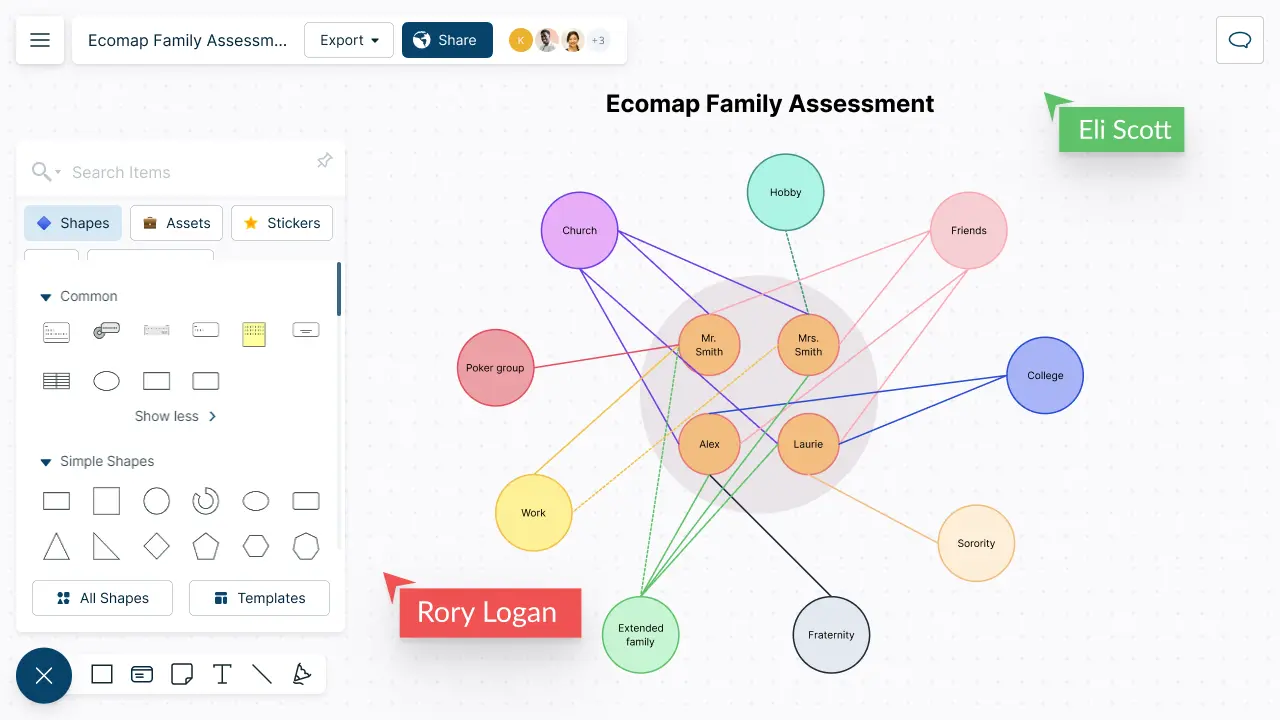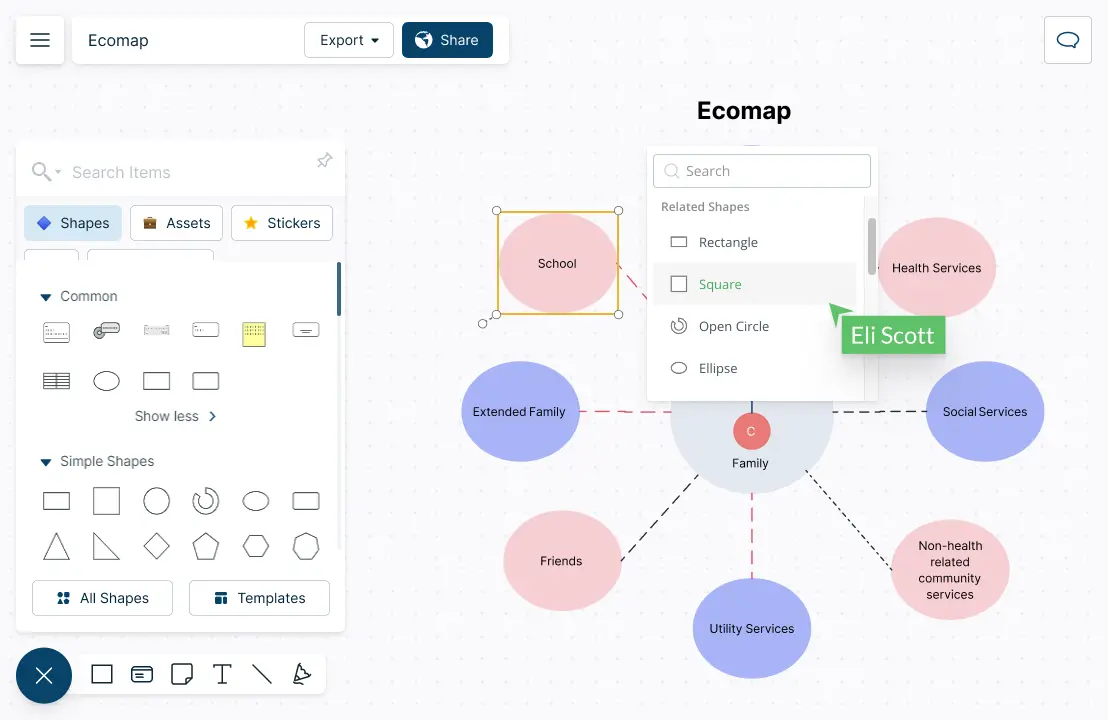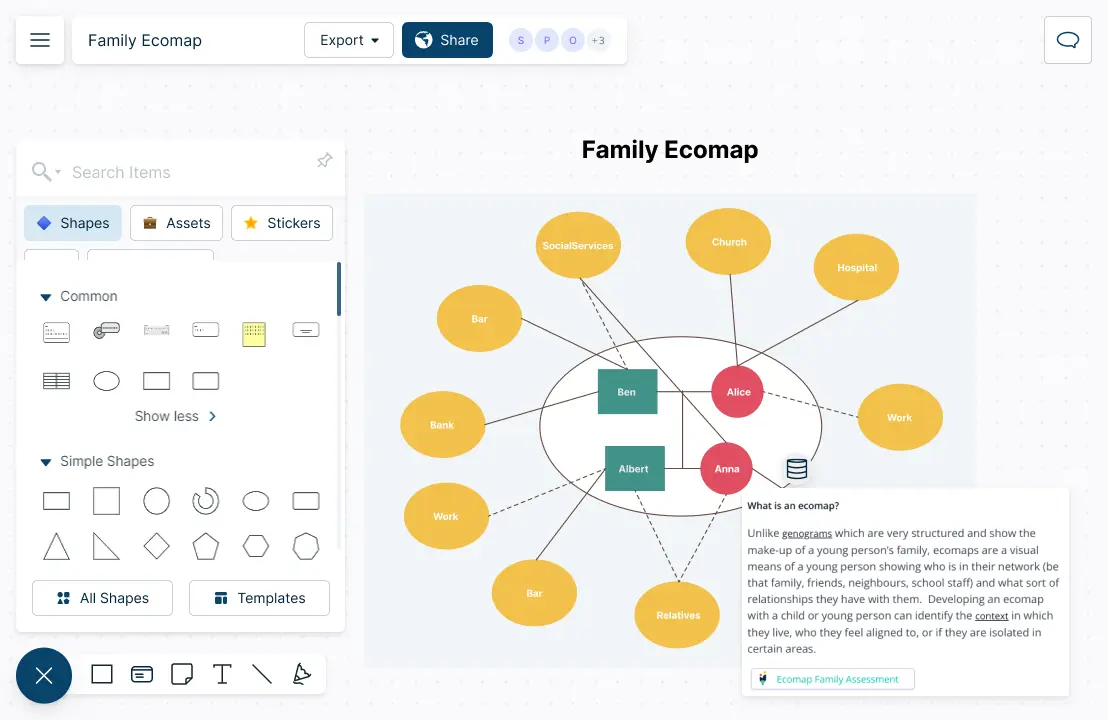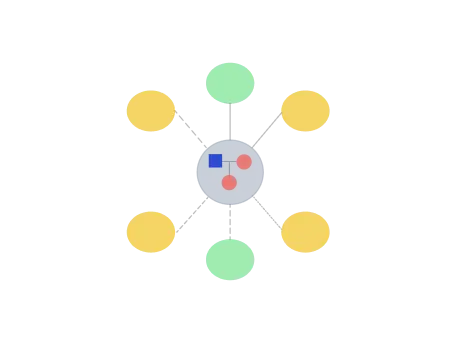Ecomap Maker Online
Better Understand Your Clients’ Relationship Dynamics
Visualize and analyze relationships in play in an individual’s life. Streamline counseling and social work assessment with intuitive visual tools.
- Get a headstart with customizable ecomap templates
- Real-time collaboration to work with clients & colleagues
- Print, download, or share your findings, reports, & research

Over 10 Million people and 1000s of teams already use Creately
How to make an Ecomap?
Create Ecomaps with Ease

- Map your client’s relationships quickly with multiple ecomap templates.
- Style ecomaps faster during assessments with preset color themes & styles.
- Depict family relationships in an instant with dynamic connectors.
- Professional shape libraries for family trees, genograms, sociograms, & more.


CONNECT & ORGANIZE
Organize All Your Data in One Place

- Gather & organize multidimensional information on clients during research.
- Add details about your client with custom shape properties & additional data fields.
- Provide more context by importing images, vectors, and more into the canvas.
- Organize information around ecomaps for effective analysis with integrated notes.
COLLABORATE
 Effortlessly Engage with Clients and Colleagues" width="644" height="419" />
Effortlessly Engage with Clients and Colleagues" width="644" height="419" />
- Work with family members and other researchers on a shared canvas.
- Comment with context, have discussions and follow-ups on the same canvas. Async!
- Embed ecomaps on any site or intranet, or use view mode for presentations.
- Easily share, review, and edit ecomaps with multiple access & role levels.
 Effortlessly Engage with Clients and Colleagues" width="644" height="419" />
Effortlessly Engage with Clients and Colleagues" width="644" height="419" />

What is an Ecomap?
An ecomap is a popular social work assessment tool that is used to visualize the social and personal relationships individuals/families have with their environment. Ecomaps are commonly used in social work and counseling as a visual representation of the various social and environmental factors that may be impacting a person’s life.
How Can You Use an Ecomap Collaboratively?
Ecomaps are often created involving the individuals or family members themselves in an interactive and collaborative setting. Their participation helps gather information and gain insights into the strengths, challenges, and relationships within the group.
An eco-map can be used collaboratively in a number of ways. For example:
- Collaborative information gathering
Individuals or family members can collaborate on creating ecomaps by sharing and contributing information about their relationships and connections to others in their social network. By working together, they can make sure all important relationships and support systems are included and the information is correct and up-to-date.
- Joint problem-solving
The ecomap can facilitate discussion and collaboration around potential solutions to problems by visualizing the challenges and strengths within a family or group. This can help them see what resources and support systems they have to help solve their problems.
- Joint decision making
An eco-map can help people make decisions together. By using the map, they can think about different choices and how they will affect the relationships and systems shown on the map.
- Building consensus
Eco-maps can help people in a family or group understand each other better and come to agreements faster. This can reduce conflicts and encourage everyone to work together.
In each of these examples, the eco-map is used as a visual tool to foster communication, collaboration, and decision-making. When individuals and family members come together to collaborate on creating the eco-map, it can help to foster a sense of empowerment and increase the chances of successful outcomes.
How to Create an Ecomap on Creately?
- Open a Creately workspace and share it with your colleagues or the client you wish to collaborate with during the interview. You can use this workspace to centralize everything from survey and interview data and to interview questions and answers. Using real-time mouse cursors and synced previews, you can easily track the changes other participants make in the workspace.
- Based on the interviews and research you have done on your client, either you can create an ecomap yourself or you can allow your client to draw it on their own.
- Select a Creately’s pre-made ecomap template or create one from scratch using the correct ecomap symbols and connections. You can invite your client to collaborate on the ecomap using a secure diagram share link with edit or review privileges where the client can leave comments.
- Draw a circle in the middle of the canvas. This is where you should list down the name of the individual. If you are creating a family ecomap, represent the family members with a genogram in the middle of the circle.
- Represent males with squares and females with circles. Write down their names and age in their representative shape.
- Round the circle in the center, draw some more circles to represent people, institutions, entities etc. your clients have relationships with.
- Draw connecting lines between the external entities and your client/s. Use the various ecomap connector types to represent the quality of the relationship. Arrowheads should be added to show the direction.
- If you wish to add your ecomap to a presentation or document you can download it as an image. If you wish to take print-outs, export it as a PDF. Using the Creately Viewer, you can also embed it in websites or blogs.







 Effortlessly Engage with Clients and Colleagues" width="644" height="419" />
Effortlessly Engage with Clients and Colleagues" width="644" height="419" /> Effortlessly Engage with Clients and Colleagues" width="644" height="419" />
Effortlessly Engage with Clients and Colleagues" width="644" height="419" />